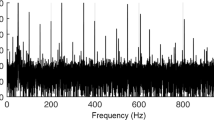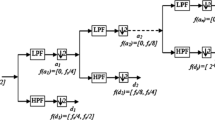Abstract
Broken rotor bar diagnosis in squirrel cage induction motors is a matter of increasing concern nowadays. The classical motor current signature analysis (MCSA), based on the Fourier analysis of the steady-state current, does not achieve good results when the motor runs in the start-up transient. In this paper, a novel approach is presented for detecting broken rotor bars (BRBs) in squirrel cage induction motors started at a constant frequency. It is shown that, in the case of motors with BRBs, the theoretical evolution of the instantaneous frequency fi of the characteristic harmonic in squared Park vector modulus signal versus slip s is always manifests itself by a straight line with slope k equal to 100, which is physically justified using theoretical analysis. In the proposed approach, the discrete wavelet transform (DWT) is used to extract characteristic harmonics from the squared park vector modulus signal. Then, the instantaneous frequency (IF) of the resultant characteristic harmonics is calculated via the Hilbert transform (HT). The occurrence of failure is determined according to the correlation between the symbolized experimental s–fi and its theoretical evolution in the s–fi plane, and the fault severity is judged according to the energy of the fault characteristic harmonic signal. Experimental results of a 3 kW motor verify the validity of the theoretical analysis and the proposed diagnosis approach during the start-up transient.












Similar content being viewed by others
Availability of data and material
The data used to support the findings of this study are included in the article.
References
Antonino-Daviu J (2020) Electrical monitoring under transient conditions: a new paradigm in electric motors predictive maintenance. Appl Sci Basel 10:16
Ganesan S et al (2021) Intelligent starting current-based fault identification of an induction motor operating under various power quality issues. Energies 14
Han L, Lei Y, Wang T et al (2017) Analaysis on rotor starting temperature rise of induction motor with heavy rotary ineria load. J Chongqing Univ 40:60–69
Zhao D, Xie G (2020) Failure analysis on broken bar of squirrel-cage rotor in traction motor. Electric Weld Mach 50:109–113
Chen JG et al (2020) A method for broken rotor bars diagnosis based on sum-of-squares of current signals. Appl Sci Basel 10:14
Li HY et al (2021) A normalized frequency-domain energy operator for broken rotor bar fault diagnosis. IEEE Trans Instrum Meas 70:10
Maouche Y et al (2019) The propagation mechanism of fault signatures in squirrel cage induction motor drives. J Electr Eng Technol 14:121–133
Lombard P, Fireteanu V, Constantin AI (2019) Influences on the electromagnetic torque and rotor force of different faults in squirrel-cage induction motors. Int J Appl Electromagnet Mech 59:805–815
Sabbaghian-Bidgoli F, Poshtan J (2018) Fault detection of broken rotor bar using an improved form of Hilbert-Huang transform. Fluct Noise Lett 17
Kim YH et al (2013) High-resolution parameter estimation method to identify broken rotor bar faults in induction motors. IEEE Trans Ind Electron 60:4103–4117
Singh G, Naikan VNA (2018) Detection of half broken rotor bar fault in VFD driven induction motor drive using motor square current MUSIC analysis. Mech Syst Signal Process 110:333–348
Sahraoui M, Cardoso AJM, Ghoggal A (2015) The use of a modified prony method to track the broken rotor bar characteristic frequencies and amplitudes in three-phase induction motors. IEEE Trans Ind Appl 51:2136–2147
Cusido J et al (2008) Fault detection in induction machines using power spectral density in wavelet decomposition. IEEE Trans Ind Electron 55:633–643
Climente-Alarcon V et al (2014) Induction motor diagnosis by advanced notch FIR filters and the Wigner-Ville distribution. IEEE Trans Ind Electron 61:4217–4227
Riera-Guasp M et al (2008) A general approach for the transient detection of slip-dependent fault components based on the discrete wavelet transform. IEEE Trans Ind Electron 55:4167–4180
Qiu AR (1995) Diagnosis of rotor fault in squirrel cage induction motors using time-varying freqency spectrum of starting stator current. Proc CESS 15:267–273
Antonino-Daviu J et al (2006) Application and optimization of the discrete wavelet transform for the detection of broken rotor bars in induction machines. Appl Comput Harmon Anal 21:268–279
Pineda-Sanchez M et al (2009) Instantaneous frequency of the left sideband harmonic during the start-up transient: a new method for diagnosis of broken bars. IEEE Trans Ind Electron 56:4557–4570
Burriel-Valencia J et al (2017) Short-frequency fourier transform for fault diagnosis of induction machines working in transient regime. IEEE Trans Instrum Meas 66:432–440
Park Y et al (2020) Airgap flux based detection and classification of induction motor rotor and load defects during the starting transient. IEEE Trans Ind Electron 67:10075–10084
Faiz J, Ebrahimi BM, Toliyat HA (2007) Signature analysis of electrical and mechanical signals for diagnosis of broken rotor bars in an induction motor. Electromagnetics 27:507–526
Yahia K et al (2014) Induction motors broken rotor bars diagnosis through the discrete wavelet transform of the instantaneous reactive power signal under time-varying load conditions. Electr Power Compon Syst 42:682–692
Ramu SK et al (2020) Broken rotor bar fault detection using Hilbert transform and neural networks applied to direct torque control of induction motor drive. Iet Power Electron 13:3328–3338
Bellini A et al (2008) Advances in diagnostic techniques for induction machines. IEEE Trans Ind Electron 55:4109–4126
Boashash B (1992) Estimating and interpreting the instantaneous frequency of a signal-part 1: fundamentals. Proc IEEE 80:520–538
Vakman D (1996) On the analytic signal, the Teager-Kaiser energy algorithm, and other methods for defining amplitude and frequency. IEEE Trans Signal Process 44:791–797
Liu ZX et al (2004) Online rotor mixed fault diagnosis way based on spectrum analysis of instantaneous power in squirrel cage induction motors. IEEE Trans Energy Convers 19:485–490
Li HY et al (2019) Modulation sideband separation using the Teager-Kaiser energy operator for rotor fault diagnostics of induction motors. Energies 12:16
Toma RN, Kim JM (2020) Bearing fault classification of induction motors using discrete wavelet transform and ensemble machine learning algorithms. Appl Sci Basel 10:21
Ordaz-Moreno A et al (2008) Automatic online diagnosis algorithm for broken-bar detection on induction motors based on discrete wavelet transform for FPGA implementation. IEEE Trans Ind Electron 55:2193–2202
Liu J, Tai N, Fan C et al (2017) A fault identification method for two-level VSC-HVDC DC line based on Pearson correlation of transient current. Trans China Electrotech Soc 32:74–85
Jiang T, Jia H, Li G et al (2017) Cross-correlation coefficient- based coherency identification in bulk.Power System Using Wide-Area Measurements. Trans China Electrotech Soc 32:1–11
Dai Z, Yan S, Zhang C et al (2018) A new pilot protection for UHVDC lines based on correlation coefficient of designed current variables. Power Syst Protect Control 46:31–38
Funding
This work was funded by the National Natural Science Foundation of China (52007078) and the Research Project of the Education Department of Liaoning Province (2019LNJC16).
Author information
Authors and Affiliations
Corresponding author
Ethics declarations
Ethics approval
Not applicable.
Consent to participate
Not applicable.
Consent for publication
Not applicable.
Competing interests
The authors declare no competing interests.
Additional information
Publisher's note
Springer Nature remains neutral with regard to jurisdictional claims in published maps and institutional affiliations.
Rights and permissions
About this article
Cite this article
Zhu, H., Jia, Z., Song, X. et al. An approach to detect broken rotor bars based on instantaneous frequency of the fault characteristic harmonic during the start-up transient. Int J Adv Manuf Technol 124, 4107–4119 (2023). https://doi.org/10.1007/s00170-022-08829-6
Received:
Accepted:
Published:
Issue Date:
DOI: https://doi.org/10.1007/s00170-022-08829-6




